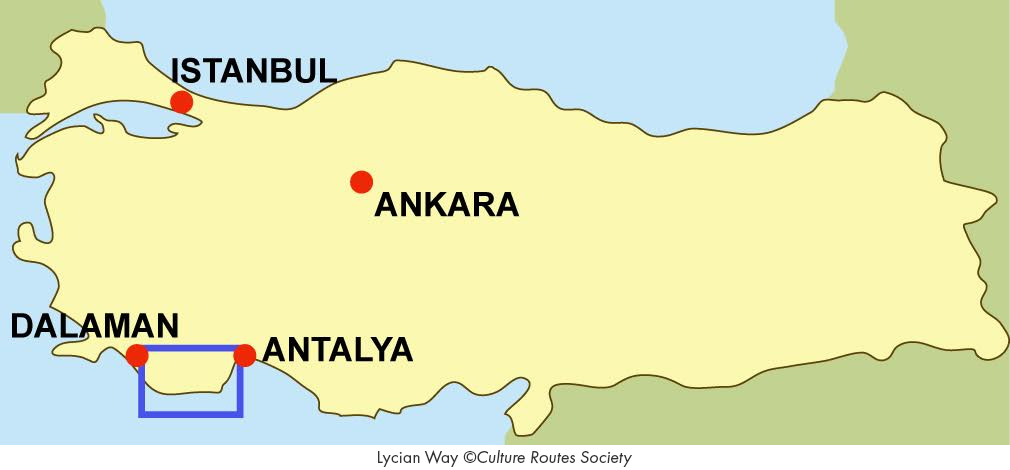 The Lycian Way is one of Turkey’s first long-distance footpaths, and winds 540 km along the mountainous southwestern coast of Turkey between Fetihye (closest airport Dalaman) and Antalya (see map above) across what is called the Tekke Peninsula. It offers magnificent views of the Mediterranean, provides access to over 25 remote historical sites from a parade of ancient civilizations like the Lycian, Greek and Roman empires; rugged scenery and fragrant forests; and some of the most friendly, welcoming locals you’ll meet. The highest altitude is 1,800 m, with an alternative route to climb Mt. Olympos (2,366 m). The level of difficulty varies.
The Lycian Way is one of Turkey’s first long-distance footpaths, and winds 540 km along the mountainous southwestern coast of Turkey between Fetihye (closest airport Dalaman) and Antalya (see map above) across what is called the Tekke Peninsula. It offers magnificent views of the Mediterranean, provides access to over 25 remote historical sites from a parade of ancient civilizations like the Lycian, Greek and Roman empires; rugged scenery and fragrant forests; and some of the most friendly, welcoming locals you’ll meet. The highest altitude is 1,800 m, with an alternative route to climb Mt. Olympos (2,366 m). The level of difficulty varies.
This area is part of ancient Lycia, home to the Lycian civilization - one of the oldest of the ancient world. Its political sophistication, culture and commercial success was the envy of many a larger and better-known civilization. “The Lycianswere a democratic but independent, warlike people, with a developed art style and a high standard of living. Their strategic position gave them unique opportunities for sea-trade and (at times) for piracy. After Persian rule, the Lycianswelcomed Alexander the Great and absorbed Greek culture. Later, Lycia became a province of the Roman Empire.” Lycian graves and ruins are scattered across the peninsula.
The variety of the trail and the natural beauty of its landscapes is its biggest delight: the rugged peaks and ridges rising steeply from the rocky shore, olive and citrus groves, meadows blooming with wildflowers in spring, pine, juniper and cedar forests, agricultural fields under intensive cultivation, rural villages, coastal bluffs, and long, white sandy beaches.
The Lycian Way follows ancient cobbled Roman roads, centuries-old footpaths, goat and mule trails, and forested paths. It has only quite recently been mapped and marked, opening in 1999 due in large part to the efforts, research and hard work of the British hiking and walking enthusiast Kate Clow. The main goal was to identify and protect some of Turkey’s ancient roads - for which advocacy continues.
It takes up to four weeks to walk the entire route, though most hikers will take guided walks supported by companies that move their luggage between stops. It is the perfect trail to walk just a section, each section having its particular charms. Much of the trail is also suitable for day hikes.
In particular, the trail also gives insight into modern rural Turkey, and allows hikers to interact with friendly and welcoming villagers – often farmers – in whose village houses it is often possible to overnight. Camping is more frequently a necessity along the East end of the trail as the small hotels and family-run guesthouses that are more easily come by on the West end of the trail become fewer and further between. This too, adds to the charm of the trail.
Trekking is best in spring or autumn – February-May or September-November.
LINKS
Culture Routes Society - Lycian Way website
Great website about the Lycian Trail and historic Lycia (People, Government, Language, Sites etc.)
Walkopedia's Lycian Trail description
RECOMMENDED READING
Kate Clow – The Lycian Way, 4th edition, June 2014
Freya Stark – The Lycian Shore (1956)
Lycian Turkey, by George E. Bean, 1989